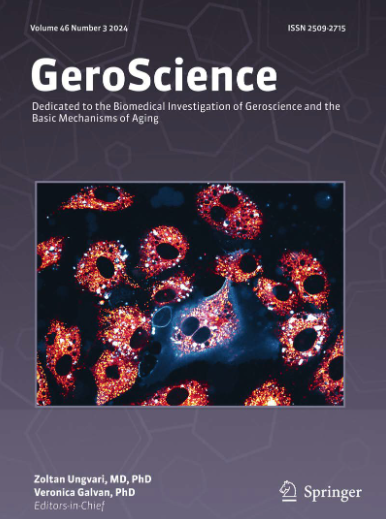探索二甲双胍对叙利亚仓鼠睾丸衰老的影响。
IF 5.4
2区 医学
Q1 GERIATRICS & GERONTOLOGY
引用次数: 0
摘要
与睾丸老化相关的生化和分子机制仍然知之甚少。在这里,我们使用叙利亚仓鼠作为自然衰老模型,观察到精子发生紊乱,睾丸重量和性腺指数减少,组织学改变,包括小管壁纤维化,胶原沉积增加,睾丸激素生成减少。这些变化与炎症和氧化应激标志物水平的增加以及细胞增殖、存活、DNA修复和自噬能力的降低同时发生。二甲双胍,除了目前的临床应用,已经被提议作为一种抗衰老药物。二甲双胍对老年仓鼠睾丸碎片的体外培养表明,二甲双胍对睾丸炎症-氧化状态的有益作用,同时刺激自噬和细胞修复DNA损伤的能力。然而,在体内每日口服二甲双胍给老龄仓鼠2个月,剂量相当于2型糖尿病患者,身体和睾丸重量、性腺指数和血糖下降,同时睾丸炎症、氧化和纤维化指标水平升高,自噬迹象下降,类固醇生成和DNA修复能力下降,精子发生受损。总的来说,虽然体外研究表明二甲双胍对衰老睾丸的有益作用是通过抗炎、抗氧化和促自噬作用来证明的,但在老龄仓鼠体内实验中,补充二甲双胍的效果完全相反。因此,二甲双胍作为睾丸抗衰老剂的未来应该进一步研究,彻底重新考虑,如果有需要,就不要考虑。本文章由计算机程序翻译,如有差异,请以英文原文为准。
Exploring the impact of metformin on testicular aging in Syrian hamsters.
Biochemical and molecular mechanisms associated with testicular aging are still poorly understood. Here, using the Syrian hamster as a natural model of aging, we observed a disturbed spermatogenesis with reduction of the testicular weight and the gonadosomatic index, altered histology including tubular wall fibrosis, increased collagen deposition, and diminished steroidogenesis in testes of aged animals. These changes took place in parallel with an increase in the levels of inflammatory and oxidative stress markers and a reduction in the cell proliferative, survival, DNA repair, and autophagic capacities. Metformin, beyond its current clinical applications, has been proposed as an anti-aging drug. In vitro incubations of testicular fragments from old hamsters with metformin revealed beneficial effects of this drug on the testicular inflammatory-oxidative state together with stimulation of autophagy and cell ability to fix DNA damage. However, in vivo daily oral administration of metformin to aged hamsters for 2 months in a dose equivalent to that usually received by patients with type 2 diabetes mellitus, reduced body and testicular weights, gonadosomatic index and blood glucose, concomitantly with increased levels of indicators of testicular inflammation, oxidation and fibrosis, decreased signs of autophagy, steroidogenesis and DNA repair capacity, and impaired spermatogenesis. Overall, while in vitro studies suggested beneficial effects of metformin in the aging testis evidenced through anti-inflammatory, anti-oxidant, and pro-autophagic actions, in vivo experiments in aged hamsters supplemented with metformin exhibited completely opposite effects. Therefore, the future of metformin as a testicular anti-aging agent should be further investigated, thoroughly reconsidered and, should the need arise, disregarded.
求助全文
通过发布文献求助,成功后即可免费获取论文全文。
去求助
来源期刊

GeroScience
Medicine-Complementary and Alternative Medicine
CiteScore
10.50
自引率
5.40%
发文量
182
期刊介绍:
GeroScience is a bi-monthly, international, peer-reviewed journal that publishes articles related to research in the biology of aging and research on biomedical applications that impact aging. The scope of articles to be considered include evolutionary biology, biophysics, genetics, genomics, proteomics, molecular biology, cell biology, biochemistry, endocrinology, immunology, physiology, pharmacology, neuroscience, and psychology.
 求助内容:
求助内容: 应助结果提醒方式:
应助结果提醒方式:


